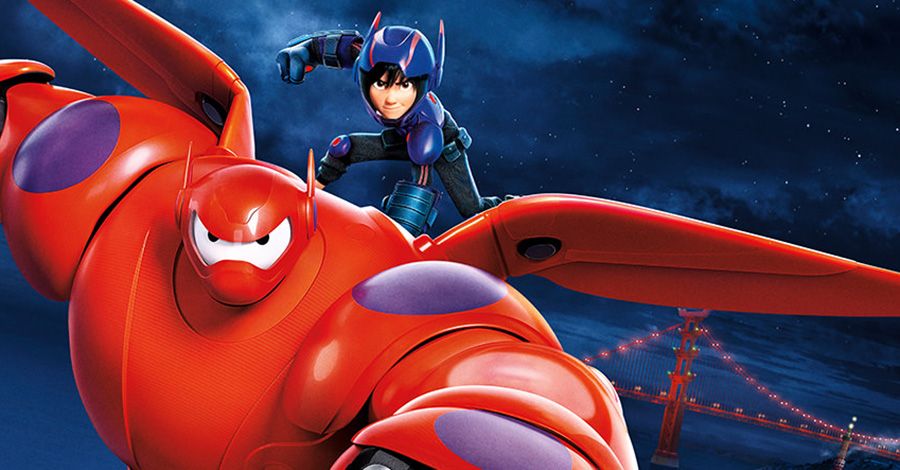The first full film effort to attempt to splice the rarefied DNA of a traditional Disney animated film with the equally distinctive essence of a Marvel superhero property, "Big Hero 6" captures many of the finest qualities of its forebears. Fun, fast-paced and packing an emotional wallop in with the comic book action, it's a good-looking offspring from two legendary storytelling brands.
Now that Marvel has been comfortably folded in to the House of Mouse following the latter's acquisition of the 75-year-old comics company in 2009, it may have been tempting to launch their first animated co-property with a somewhat more well-known and/or kid-friendly project like "Power Pack." But wisely Disney -- at the suggestion of co-director Don Hall, who helmed the film along with Chris Williams -- zeroed in on a more under-the-radar Marvel diamond-in-the-rough with Big Hero 6, the intriguing but semi-obscure Japanese super-team which came with as few preconceived expectations as possible as far as iconography goes. It allowed the filmmakers to re-work wherever they needed to without offending longtime fan sensibilities.
The end result was a premise set firmly in its own environment, outside the established Marvel Cinematic Universe and worlds away from the classic fairy tale lands that populate many Disney films. Set in the somewhat futuristic San Fransokyo -- a visually sumptuous geographical mash-up of San Francisco and Tokyo -- the story centers on 14-year-old robotics prodigy Hiro Hamada (Ryan Potter), whose squandering his potential in underground 'bot fighting rings until his similarly brilliant older brother Tadashi motivates Hiro to apply to the elite tech school where Tadashi was recently admitted.
But a tragedy strikes at the school after Hiro demonstrates his stunningly versatile microbots -- swarms of tiny robotic parcels that can combine into infinite forms, shapes and structures at lightning speed -- leaving Tadashi dead and Hiro bereft and struggling with his mourning -- and in the unexpected care of the inflatable health care robot Baymax, Tadashi's proudest creation, dispensing medical advice while looking like an Apple product come to life. Equal parts benign and overzealous, Baymax's efforts to understand and treat Hiro's emotional pain as if it were a physical wound led to many inventive comedic moments. As the voice of Baymax, former "30 Rock" star Scott Adsit delivers a one-of-a-kind performance, capturing the stilted other-ness of A.I. ranging from "2001's" HAL to iPhone's Siri, but investing it with a perfect inflection of warmth and compassion to make him feel alive enough to root for. As a character, Baymax is an instant classic, inherently lovable and ideally conceived for our tech-comfy age.
The plot thickens when Hiro realizes his microbots have been highjacked by a nefarious Kabuki-masked supervillain Yokai, inspiring the boy genius to adapt his tech to make himself and Baymax into armored superheroes, along with an assembly of Tadashi's equally super-smart classmates: bubby chemistry whiz Honey Lemon (Genesis Rodriguez), neurotic laser expert Wasabi (Damon Wayans, Jr.), non-nonsense electromagnetic skater GoGo Tomago (Jamie Chung) and Fred (T.J. Miller), the blissed-out fanboy Fred, who takes kaiju cosplay to a new level.
The opening half of the film is largely the most Disney-fied, on a story level. Something special has been happening lately within Disney Animation headquarters -- "Wreck-It Ralph" and "Frozen" both had pitch-perfect ears for the emotional qualities and story beats that moved and motivated their characters, and the comedy inherent in them. "Big Hero 6 continues Disney's new Golden Age, if not quite as spectacularly as its two recent predecessors. The filmmakers mine the most emotion and comedy out of the characters and situations they've conceived, making it easy for audience to invest.
Similarly, the Marvel portion of the equation is best served in the film's second half, where the action inventively amps up and the story's super-powered elements emerge to great effect. Hiro and Baymax carry much of the action as the dynamic duo, but the scenes they share with the rest of their team are genuinely thrilling, and each member of Big Hero 6 gets their big moment.
If the film needs any fine-tuning, it's in the blending of the sensibilities of its parent material. As distinctively Disney as the first half of the film is, and as powerfully Marvel as the back end becomes, each portion could have borrowed just a pinch more of the other's magic to come together a bit more cohesively. There is a sense that we're watching a set of characters move from one kind of movie into another kind of movie -- but for the most part, both factors work like gangbusters.
What really sets "Big Hero 6" apart from other recent animated fare, Disney or otherwise, is the sheer beauty of its visuals, whether it be a scene wordlessly expressing Hiro's deep sense of loss or one in which he's rocketing into action atop Baymax's back. Each frame is so carefully, thoughtfully and artfully constructed, so deftly packed with depth and detail never quite before seen on this scale, that despite its computer-generated origins, the world feels warmer and more human in many ways than a live-action film, and as attentively handmade as Disney traditionally animated catalogue of films. In that way, it's not unlike Baymax in the film: a product of cutting-edge technology that reveals itself to be surprisingly emotionally appealing.

